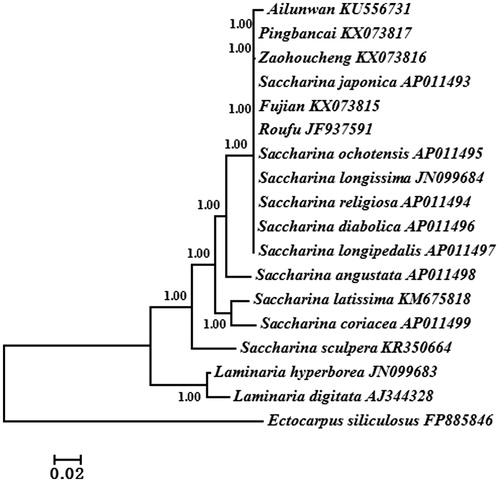Abstract
In this work, complete mitogenome of Saccharina japonica cultivar ‘Fujian’ was reported. It had circular mapping organization with the length of 37,638 bp and encoded 66 genes including three rRNAs, 25 tRNAs, 35 known proteins, and three ORFs. Gene arrangement and component were conserved in those reported Saccharina species and cultivars. Only 33 nucleotide substitutions were found according to the total alignment of S. japonica and ‘Fujian’. The intergenic region of 19 nucleotides which is located between rps3 and rps9 in S. japonica mitogenome was not detected in ‘Fujian’. Phylogenetic analysis showed that ‘Fujian’ had a closer relationship with S. japonica and cultivar ‘Rongfu’ which strongly supported its genetic origin and phylogenetic relationship of Chinese Saccharina cultivars.
Saccharina (Laminariales, Phaeophyceae) is one of the most important seaweeds owing to its economic importance and global distribution (Kain Citation1979). In China, about 20 Saccharina cultivars have been bred (Li et al. Citation2007; Zhang et al. Citation2007, Citation2011b) and most of them were selected from S. japonica. ‘Fujian’ mainly cultured in South China was a S. japonica cultivar without any systematic selection. Here, we characterized the complete mitogenome of ‘Fujian’, gave the comparison with that of S. japonica (accession number: AP011493) and construct phylogenetic analysis to provide new molecular data for genetics study.
‘Fujian’ specimen (specimen number: 201005125) was collected from Putian, Fujian, China (25°43′N, 119°00′E) and stored at –80 °C for DNAs isolation. The experimental procedures and data processing followed Zhang et al. (Citation2011a).
The ‘Fujian’ mitogenome was a circular molecule of 37,638 bp (GenBank accession number KX073815). The overall AT content was 64.66% exhibiting a high AT richness. Cumulative GC-skew and AT-skew analysis reflected a slight bias towards G and T on H-strand. The protein-encoding regions were 29,007 bp, the spacer size was 2426 bp and the overlap was 95 bp. One obvious gene cluster (rps8–rpl6–rps2–rps4) conserving in the reported Saccharina mitogenomes was also found here. The mitogenome encoded 66 genes, including three rRNAs (23S, 16S, and 5S), 25 tRNAs, 35 protein-encoding genes, and three ORFs. With the exception of rpl2, rpl16, rps3, rps19, tatC, and ORF130, 60 genes were encoded on H-strand. The universal genetic codes were used. All protein-encoding genes started with ATG codon. Approximately, 68.42% terminated with TAA codon, higher than that for TAG (21.05%) and TGA (10.53%). Moreover, all tRNA sequences could form standard clover-leaf secondary structures. Gene arrangement and component were identical with those reported Saccharina mitogenomes (Yotsukura et al. Citation2010; Zhang et al. Citation2013, Citation2017).
Compared to the mitogenome of S. japonica, 33 nucleotide substitutions were found in ‘Fujian’. One intergenic region of 19 nucleotides, which was located between rps3 and rps9 in S. japonica, lacked from ‘Fujian’ mitogenome. This resulted in the mitogenome size of ‘Fujian’ being 19 bp shorter than that of S. japonica.
wBayesian analysis based on the whole mitogenome sequences shared by 17 Saccharina and Laminaria algae was utilized to reconstruct the phylogeny (). Ectocarpus siliculosus was used as outgroup. All algae were divided into two clades: Saccharina (including all Chinese cultivars) and Laminaria. Phylogenetic analyses showed that ‘Fujian’ firstly groups with S. japonica and ‘Rongfu’ which supported its genetic origin and relationship of Chinese cultivars.
Disclosure statement
No potential conflict of interest was reported by the authors.
Additional information
Funding
References
- Kain JM. 1979. A view on the genus Laminaria. Oceanogr Mar Biol Annu Rev. 17:101–161.
- Li XJ, Cong YZ, Yang GP, Qu SC, Li ZL, Wang GW, Zhang Z, Luo S, Dai H, Xie J, et al. 2007. Trait evaluation and trial cultivation of Dongfang No.2, the hybrid of a male gametophyte clone of Laminaria longissima (Laminariales, Phaeophyta) and a female one of L. japonica. J Appl Phycol. 19:139–151.
- Yotsukura N, Shimizu T, Katayama T, Druehl LD. 2010. Mitochondrial DNA sequence variation of four Saccharina species (Laminariales, Phaeophyceae) growing in Japan. J Appl Phycol. 22:243–251.
- Zhang J, Li N, Liu N, Liu T. 2017. The complete mitogenome of “Zaohoucheng”, an important Saccharina japonica cultivar in China. Mitochondrial DNA B: Resour. 2:656–657.
- Zhang J, Li N, Zhang ZF, Liu T. 2011a. Structure analysis of the complete mitochondrial genome in cultivation variety “Rongfu”. J Ocean Univ China. 10:351–356.
- Zhang J, Liu Y, Yu D, Song HZ, Cui JJ, Liu T. 2011b. Study on high-temperature-resistant and high-yield Laminaria variety “Rongfu”. J Appl Phycol. 23:165–171.
- Zhang QS, Tang XX, Cong YZ, Qu SC, Luo SJ, Yang GP. 2007. Breeding of an elite Laminaria variety 90-1 through interspecific gametophyte crossing. J Appl Phycol. 19:303–311.
- Zhang J, Wang XM, Liu C, Jin YM, Liu T. 2013. The complete mitochondrial genomes of two brown algae (Laminariales, Phaeophyceae) and phylogenetic analysis within Laminaria. J Appl Phycol. 25:1247–1253.

